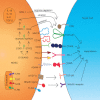The immunosuppressive tumour network: myeloid-derived suppressor cells, regulatory T cells and natural killer T cells
- PMID: 23216602
- PMCID: PMC3575763
- DOI: 10.1111/imm.12036
The immunosuppressive tumour network: myeloid-derived suppressor cells, regulatory T cells and natural killer T cells
Abstract
Myeloid-derived suppressor cells (MDSC) and regulatory T (Treg) cells are major components of the immune suppressive tumour microenvironment (TME). Both cell types expand systematically in preclinical tumour models and promote T-cell dysfunction that in turn favours tumour progression. Clinical reports show a positive correlation between elevated levels of both suppressors and tumour burden. Recent studies further revealed that MDSCs can modulate the de novo development and induction of Treg cells. The overlapping target cell population of Treg cells and MDSCs is indicative for the importance and flexibility of immune suppression under pathological conditions. It also suggests the existence of common pathways that can be used for clinical interventions aiming to manipulate the TME. Elimination or reprogramming of the immune suppressive TME is one of the major current challenges in immunotherapy of cancer. Interestingly, recent findings suggest that natural killer T (NKT) cells can acquire the ability to convert immunosuppressive MDSCs into immunity-promoting antigen-presenting cells. Here we will review the cross-talk between MDSCs and other immune cells, focusing on Treg cells and NKT cells. We will consider its impact on basic and applied cancer research and discuss how targeting MDSCs may pave the way for future immunocombination therapies.
© 2012 Nijmegen Centre for Molecular Life Sciences Immunology © 2012 Blackwell Publishing Ltd.
Figures


References
-
- Dougan M, Dranoff G. Immune therapy for cancer. Annu Rev Immunol. 2009;27:83–117. - PubMed
-
- Kantoff PW, Higano CS, Shore ND, et al. Sipuleucel-T immunotherapy for castration-resistant prostate cancer. N Engl J Med. 2010;363:411–22. - PubMed
-
- Tacken PJ, Zeelenberg IS, Cruz LJ, Van Hout-Kuijer MA, Van de Glind G, Fokkink RG, Lambeck AJ, Figdor CG. Targeted delivery of TLR ligands to human and mouse dendritic cells strongly enhances adjuvanticity. Blood. 2011;118:6836–44. - PubMed
-
- Hanahan D, Weinberg RA. Hallmarks of cancer: the next generation. Cell. 2011;144:646–74. - PubMed
Publication types
MeSH terms
LinkOut - more resources
Full Text Sources
Other Literature Sources

